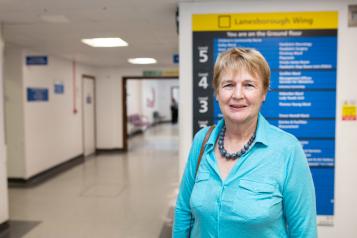Increased stability in social care and real collaboration across health and care key to mitigating risk of “tsunami of unmet need”

This year, the success of the vaccination programme has given hope that the virus can be contained. Alongside this hope, however, is the recognition that COVID-19 will continue to cast a long shadow over all aspects of life, especially the health and care system.
The system has not collapsed – but the system is composed of individuals who deliver and receive care, and the toll taken on many of these individuals has been heavy. As we approach winter, the workforce who face the challenges ahead are drained in terms of both resilience and capacity, which has the potential to impact on the quality of care they deliver.
Staffing pressures are being felt across all health and care settings. However, the impact is being seen most acutely in adult social care, where providers are competing for staff with the retail and hospitality industries. Data from information submitted to CQC by providers of residential care shows the vacancy rate rising month-on-month from 6% in April to 10.2% in September. Some care homes whose attempts at recruitment have failed are now having to cancel their registration to provide nursing care, leaving residents looking for new homes in local areas that are already at, or close to, capacity.
The government has made a welcome £5.4 billion investment to help address the challenges faced by social care. If this money is to make a difference, it must be used to enable new ways of working that recognise the interdependency of all health and care settings, not just to prop up existing approaches and to plug demand in acute care. Five hundred million pounds has been committed to support the adult social care workforce, which is urgently needed for improvements on training, career development and terms and conditions in order to attract and retain staff. Work needs to begin now in order to address the immediate problem of rising vacancy rates as well as planning for the future.
Increased stability in social care is the key to unlocking not only improved access and quality of care for the people who use it, but to easing pressure on the NHS by reducing emergency attendances and enabling people to leave hospital in a timely way. There is short-term funding currently in place to help discharge patients who are no longer in need of hospital care but who may still require care services – this has allowed the NHS to treat more patients and has made a crucial difference to the viability of some social care providers.
If this funding were to be committed to for a longer period, care providers could begin to make longer term investments in staffing to provide much-needed step-down care. They could also build more meaningful relationships with primary, secondary and community care services – as well with third sector organisations and with carers, who have too often been the missing piece of the jigsaw. There is also a need for additional funding to be made available now, rather than next year, to areas that will otherwise struggle to meet people’s needs over the coming winter.
As the number of people seeking emergency care continues to rise, leading to unacceptable waiting times for ambulances and in emergency departments, measures that improve capacity and patient flow are urgently needed. Close working between providers, commissioners and all other parts of the health and care system will be essential to safely manage risk through the forthcoming winter.
Ultimately however, new models of care are necessary to ensure that people receive the care they need where and when they need it. This would mean people are less likely to be inappropriately funnelled into emergency departments – and that primary care services are able to focus on those with complex co-morbidities, rather than patients who could be better treated in other settings and by other allied health professionals. And as waiting lists for investigations and treatment lengthen, ensuring that they are managed well, fairly, and safely will be vital – closer collaboration with primary care services and third sector organisations will be key to this.
As highlighted in last year’s State of Care, COVID-19 has exacerbated inequalities and continues to do so, meaning that people who were less likely to receive good care before and during the pandemic are in many cases the same groups disproportionally impacted by the virus.
People with a learning disability, for example, are significantly more at risk from COVID-19 – but our review of community care for people with a learning disability found that their physical health, including how COVID-19 may present, was not always considered. Inspections of services for people with a learning disability or autistic people continue to find examples of care so poor that action is needed to keep people safe.
CQC has also maintained a strong inspection focus on maternity care, with our recent report highlighting disparities in experiences and outcomes for Black and minority ethnic women. Although there is much good care, we remain concerned about maternity services, with 4% rated inadequate and 37% rated requires improvement for safety.
In both instances, concerns about quality of care predate COVID-19. While specific staffing issues – shortages of midwives and learning disability nurses – have further heightened problems. CQC has highlighted the need for wider improvements in culture, leadership and genuine engagement with people who use services, in both maternity services and services for people with learning disability and or autism. We will maintain our focus on these services, supporting improvement and taking action to protect people where necessary.
In the longer term, the role of Integrated Care Systems (ICSs) will be to ensure that all parts of the health and care system work better together to respond to the needs of their local community – a transformation that may well require fundamental changes to funding, oversight, and commissioning. Designing services around local need must be the priority, ensuring people get the right treatment in the right place at the right time, with good, safe care delivered by a workforce who are valued and supported.
Ian Trenholm, Chief Executive of CQC, said:
“This year, more people than ever have contacted us with feedback and concerns about care. And as we go into winter, the health and care workforce are exhausted and depleted – which has clear implications for the vital care they deliver.
“While staffing is an issue for all sectors, we’re particularly concerned about adult social care. We’re seeing rising vacancy rates, some providers having to hand back their registrations as they don’t have enough staff to deliver care, and examples of quality suffering due to lack of staff.
“If the new Government funding is to have an impact, it needs to be used to do things differently and to develop genuinely collaborative ways of working across all care settings. And staff need to be supported and rewarded. In order to attract and retain the right people to work in adult social care, there must be a sharp focus on developing a clearly defined career pathway – linked to training, supported by consistent investment, and better terms and conditions and pay.
“We’re also highlighting the need for an extension to the Discharge to Assess funding in order to capitalise on the benefits it has delivered so far – as well as the need for additional targeted funding immediately to help areas that are struggling get through winter.
“Increased stability on funding and a clear workforce plan for social care benefits everyone – but further instability could result in a ripple effect across the wider health and care system which risks becoming a tsunami of unmet need across all sectors, with increasing numbers of people unable to access care.”
Peter Wyman, Chair of CQC, said:
“We know that better, more coordinated care for people happens when local services work well as a system designed around local need. There is no silver bullet to the problems health and social care are facing – so it is more important than ever that we make best use of the resources available by local systems working together to make sure people are being cared for in the most appropriate place, reallocating resources as necessary to achieve this.
“When we conducted a series of provider collaboration reviews across England to look at how systems worked to understand their local populations, we saw how good collaboration made a difference in helping people access care, even during the pandemic.
“The challenge now is for every system to learn from these examples of innovation to ensure that their local population receives the care it needs, with leaders focused on delivering a transformation in the way that people access and experience care. The future must be focused on outcomes for people – all people – who need care, supported by transformational changes to workforce, funding, commissioning and oversight.
Rather than attempting a return to business as usual, we must grasp this opportunity to build something better – a health and care system that works for everyone.”


